Grants of up to £30,000 are available
Nearly £1,200,000 allocated since the scheme began
Despite the extremely difficult times for the industrial heritage sector due to Covid-19, the AIA Restoration Grant scheme has still been able to offer vital funds to a wide range of industrial heritage restoration projects, thanks to the continuing support of our anonymous donors.
Even before the pandemic the preservation of the industrial heritage had become increasingly dependent on such aid and, indeed, the AIA Restoration Grants were repeatedly mentioned and welcomed by several speakers at the Summit on Industrial Heritage, held by the All Parliamentary Party Group on the Industrial Heritage (APPG IH) at the Victoria & Albert Museum in 2019.
The first of these grants were made in 2009, and from the initial modest beginnings we have since been able to allocate nearly £1.2 million (up to June 2023). A brief history of the scheme and details of many of those projects can be found below.
Regular updates on progress with these projects appear in I A News, our quarterly bulletin.
From 2020 onwards the available Grants pot is divided into two categories:
- Major projects where the maximum grant that can be awarded is £30,000. The grant from the AIA must be a significant part of the total project cost, not just a small contribution to a very large project, so that the AIA grant has real impact. The AIA would not normally fund projects where our grant represents less than 20% of the total project costs;
Small projects where the grant limit is £10,000, for which the total cost of the project, excluding the value of volunteer labour, must not exceed £12,500.
Download the Criteria and Guidance and a Restoration Grant Application Form
A brief history of the AIA Restoration Grant Scheme 2009-2023
Back in 2009 one of our members approached the AIA Chairman offering to make a sum of £30,000 available to grant aid projects. The anonymous donor was keen that the money would be for a significant part of capital works allied to volunteer input and if the scheme attracted worthwhile applicants it might be continued in subsequent years! This was a somewhat tentative beginning to a grants scheme that has seen the AIA becoming a truly significant player in the preservation of the industrial heritage. The initial modest foray into the restoration field in 2009 produced four very disparate awards. Though some of these projects took longer than others, all were eventually completed and reported as such in IA News. In the following years the attendant publicity generated an ever-more numerous and wide-ranging list of applications, many seeking quite substantial funds and the maximum award per project was raised from £15,000 to £20,000 in 2014 and will be raised to £30,000 for 2024. There was also a second category of awards – Minor Grants – created in 2020 with a maximum of £7500 which is being raised to £10,000 for 2024.
The range of applications also greatly widened. Thus IA News over the next few years was able to report on: the repairs to narrowboat Tarporley, the restoration to working order of the papermaking machine at Frogmore Mill, the rebuilding of the wagon weighbridge at Wharf Station on the Tallyllyn Railway, the excavation and interpretation of Wellington Wheel Pit at Mellor Mill, the restoration of a rare Robey under-type steam engine, the restoration of the Ellen Road Petrie Beam Engine and the restoration of the Windermere Steam launch Osprey. In recent years the generous increase in funds from our original benefactor was augmented by those from a second anonymous donor and we have witnessed a huge increase in applications to the Grant scheme. Transport projects remain a large component of these applications. These, in addition to the sites and artefacts mentioned above, include:
- Canals:Locks, such as the unique graving dock lock on the Stover Canal and Bowbridge Lock at Stroud, the Diglis Basin Crane the Saul Junction swing bridge, the Wappenshall canal warehouses and canal boats as such the narrowboat President and the lighter Susan.
- Railways: Railway buildings, structures and equipment, such as the Ferryhill turntable and in Swindon the GWR Pattern Store; standard and narrow gauge railway engines such as a 1940 diesel GWR Railcar, the 1949 William Murdoch, the 1906 locomotive Desmond, the 15 inch gauge Thorpe Light Railway locomotive, the WW1 armoured Simplex rail tram car, a rare tamping engine, railway carriages and wagons of all shapes and sizes including the LNER Thompson coach, the Lion Salt Works salt wagon and the Ryde Pier Tram.
- Vessels: such as sailing barges Dawn and Brittannia, the steam launch Lady Elizabeth, the lifeboat Swan, the steamship Freshspring and the steam tug Kerne.
- Road: the 1827 engine house and shaft of the Thames Tunnel London, vehicles such as an electric coal lorry, a 1929 St Johns ambulance and a 1927 cast iron Bus shelter,
Almost all aspects of the industrial heritage have been covered by AIA grants:
- Repairs to windmills such as Billingford, Old Buckenham and Danzey Green, watermills, and steam mills such as Beeleigh.
- Mill buildings, engines and associated machinery also feature regularly in the list, including mills such as Grane Mill at Haslingden the Museum of Carpet in Kidderminster and chimneys as at Bancroft Mill, the 1802 Boulton & Watt engine at the Verdant Works in Dundee, the Leigh Spinners Mill engine, a 1930s paper pulp beater at the Apsley Paper Trail, a 1920s sock-knitting machine at the John Smedley Archive Trust and the line shafting at Bristol Underfall Yard.
- Agricultural portable steam engines and machinery such as the Empress of Britain and the road roller Stumbles, a 1952 steam crane at the Amberley Museum.
- Mines and Mining equipment such as Big Pit Headgear, the roof of Hemingfield Colliery Winding Engine House, cranes and excavators such as the Bath Quarry crane, the Bucket Excavator at the National Mining Museum England, and the water-powered pump-rod system at Wheal Martyn china clay works.
- Furnaces and kilns such as the 1820s blast furnace stack at Brymbo, a limekiln at Gradbach.
There have been some more unusual but nevertheless significant awards: The Colonsay iron light chamber, the rare Penistone cinema organ, the Coker twine works, the Woodbury gashouse, the lead smelter remains at Crich, Grane Mill chimney at Haslingden, and the 1812 header pond for steam engines at Crofton Pumping Station.
So far, over the fifteen years of the scheme, well over £1 million has been donated which has attracted a further £250,000 Gift Aid, enabling more than eighty restoration projects to be grant aided.
Details of all the awards can be found below:
Restoration Grants 2023
This year there was a return to more normal numbers of applications. There were 21 acceptable applications, seven of which were for Small Project grants and they all used the November 2022 criteria published on the AIA website. The spread was: five buildings, one railway bridge, three items of rolling stock, three locos, four vessels, two canal projects, one road vehicle and three items of machinery. A revised application had also been received for Bancroft Mill Chimney and this met the reservations expressed last year about the detailed conservation techniques, so it was recommended that the ring-fenced grant of £20,000 be released.
After due consideration by the Restoration Grant Panel, and approval by the Council, it was decided to award seven Major Project Grants totalling £116,000 and four Small Project Grant totalling £28,800. Total for all eleven applications was £144,800.
Major Projects
Brunel Museum, Tunnel Shaft and Engine house
The Brunel Museum is located in Southwark, on the site of the Thames Tunnel excavated and comleted by Sir Marc and Isambard Kingdom Brunel in 1843. The world’s first tunnel built under a navigable river, it was an achievement of staggering proportions, rightly christened ‘the eighth wonder of the world.’ The small educational charity which runs the Museum was awarded a grant of £20,000 towards the cost of restoring the Tunnel and Engine House. This includes stabilisation of key structural brickwork in The Engine House; repair of damaged brickwork on the chimney shaft; the removal of invasive damp from both The Engine House and the Tunnel Shaft; the removal of vegetation from The Engine House walls and Tunnel Shaft roof to allow for repairs to structural and surface cracks, loose bricks and mortar; making repairs to piazza grounds caused by significant root damage; and improvements to the thermal envelope of the buildings’ openings e.g. doors and windows.
When the restoration is complete, it is anticipated that 60,000 virtual and actual visitors will be attracted annually to the Museum.
Haslingden Grane Mill – Northlight Weaving Shed Emergency Project
Grane Mill was a state of the art weaving mill built in 1907 when Cotton was King. Originally a scheduled monument and grade II* listed building, the increasingly rare 160ft chimney is complete with over-sail top and proudly declares its name, ‘GRANE”, for all to see. All the mill’s essential building elements survive, including the Engine and Boiler houses with unique almost completely restored Mill Engine, made in Haslingden, which can now be demonstrated by electric motor. Looms are being returned to the North-light Shed and brought back to working order to weave once more.
The importance of Grane Mill was first recognised by the steam plant being given Scheduled Ancient Monument protection by English Heritage in 2004. Following the Lancashire Mills study archaeological analysis, its Northlight Shed and offices were designated Grade II*. The reasons given by Historic England in the listing are its great rarity, being an Edwardian Mill with each different building element surviving with well-preserved managerial and process buildings as well as complete in situ steam engine, boiler plant and chimney. The Edwardian technology of late Stott engine, automatic stokers and the wide span Northlight Shed are specifically mentioned as is the architectural quality and design concept of single storey process flow plan form relating to the power plant. It specifically mentions the discrete shaft race for the efficient transfer of power. It is the Northlight Shed and Shaft Race which are the main focus of the current project together with related issues, for which application was made and the grant awarded.
The site is being developed into a working museum to not only rescue vanishing regional heritage, but to use machinery conservation, operation and repair opportunities to provide practical basic training in heritage machinery skills, while allowing visitors insight into Lancashire lives through the prism of the engineering that sustained our families and local communities for decades.
Ironbridge Gorge Museum, two Sentinel locomotives
The Ironbridge Gorge Museums Trust was awarded Restoration Grant of £10,964 towards its project to restore two ‘Sentinel’ Locomotives. This project will, conserve and restore two historically important objects which are part of IGMT’s Designated collection:
- Locomotive 6155 – built by Manning-Wardle in 1860, this is the most complete of the two locomotives within this project;
- Locomotive 6185 – built by the Coalbrookdale Company c1865, this locomotive is incomplete but does allow visitors to the museum to view the inner workings.
The Sentinel Waggon Works Ltd. of Glasgow and Shrewsbury are best known for their steam road waggons, but from the early 1920s they began modifying railway locomotives by removing the old boiler, cylinders and running gear and in their place fitting a Sentinel waggon engine and boiler with chain drive to both axles. The locomotives within this project are the oldest locomotive conversions carried out by Sentinel, that are known to have been preserved.
East Lancs Railway, 19th century family saloon carriage
The East Lancas Railway was awarded a grant of £17,000 to undertake the restoration of the Lancashire and Yorkshire Railway (LYR) Family Saloon No 12 – the only remaining carriage of its type from this once-thriving independent railway company. Despite LYR’s impressive credentials, very little survives today to evidence the scale of the network and the impact of the railway on industry and society across the North. Much of the railway infrastructure was demolished and only 21 carriages remain, with the majority in such poor condition that restoration is no longer viable.
Restoration of the Family Saloon therefore presents an exciting – and significant – opportunity to preserve a vital piece of industrial history and, for the first time, enable thousands of visitors annually to connect with its heritage. It is the only example of such a vehicle from LYR’s stock of 4,360 carriages and was designed specifically for the transportation of a family. It was constructed at Newton Heath Works in East Manchester, the main carriage building facility for the Lancashire and Yorkshire Railway. Designed under the leadership of Frederick Attock, the works developed a standardised method of carriage construction which was revolutionary in the industry for its time. The doors and window frames were standard fits and created a distinctive style which continued until the end of the 19th century. In its latter years, the saloon was converted into a Directors’ Saloon and was used by the Directors of Newton Heath LYR Football Club – the same team which, in 1902, become Manchester United. There is every possibility that the Directors that led the way in making the world’s most famous football team were transported in this carriage.
The vehicle is wooden-bodied but on a later steel underframe. The body frame is sound and is capable of being lifted. The interior fixtures and fittings exist and are located in storage in Rochdale. It is currently stored outside and under tarpaulin at East Lancashire Railway’s Buckley Wells works – at continued risk of further deterioration due to weather or potential vandalism.
SUC Montgomery Canal, Crickheath wharf wall
Shropshire Union Canal Society (SUCS) applied for a Restoration Grant to help finance the restoration of the Crickheath South canal wharf. This wharf is located on the Montgomery Canal approx. 6km southeast of Oswestry in the hamlet of Crickheath, Shropshire (Grid Ref SJ292 234) and was the terminus of a tramway connecting the Porth-y-waen quarries to the canal, the loading point being the Crickheath South wharf.
The limestone trade was the primary reason to build the canals here both for agricultural use after burning as lime and for the various areas of ironworks in Denbighshire around Ruabon and further afield in southeast Shropshire. The wharf operated throughout the 1800s and up to WW1, indeed there was a major upgrade and maintenance investment c1897. The coming of the mainline railway in 1860 was a major competition and volumes certainly reduced from then on. The wharf is constructed of limestone rock with sandstone copings of varying dimensions. Its height varies, presumably according to the type of operation being carried out. There is one section particularly raised where the tipping frame stood, a relatively late addition, which enabled the tramway wagons to be tipped. There are some rails still in situ, mainly in an area which has become overgrown with trees and shrubs.
St John Ambulance, 1929 Model-A Ford ambulance
Sympathy, a Ford Model ‘A’ Ambulance purpose-built in 1929, is one of the oldest remaining ambulances in the country, and the only historical ambulance remaining in the ownership of St John Ambulance, the nation’s leading first aid charity since 1877. Years of going out to events have taken their toll, and we are applying for funding to restore this significant historical vehicle to her former glory. Sympathy has a strong story to tell, appealing to audiences with an interest in social and industrial history, history of health and caring as well as historic cars. Due to her nature, she has the opportunity to be enjoyed in person by people around the country, as well as reach a wider audience online and through partnerships.
Sympathy was manufactured in 1929 at Ford’s Manchester Works in Old Trafford. She was commissioned for the St John Ambulance Sidmouth Division, and spent her first ten years serving in Sidmouth before being transferred to the City of London to work as a rescue vehicle during the Second World War. The ambulance was heavily used during the London Blitz, rescuing casualties from bombed buildings in the City of London and the East End. After many years of intensive and exceptional service, Sympathy was decommissioned and sold in 1947.
In the 1980s, the ambulance was re-discovered on a farm where she was being used as a chicken shed. Volunteers from St John Ambulance recovered the vehicle and subsequently undertook major restoration work to restore the vehicle to her original condition.
Bressingham Steam Museum, Burrell threshing machine
In February 2023, Bressingham Steam Museum acquired Burrell threshing drum no.1121. It was built between 1880 and 1890. The Threshing drum was a hugely important invention in the development of farming and agriculture. Before their invention, threshing was done by hand. It is a mechanised way to separate grain from the straw. The introduction of the Threshing drum is one of the earliest signs of the mechanisation of agriculture. It made threshing a much less laborious process and was much quicker, requiring less people for the process. This particular threshing drum was produced by Charles Burrell & Sons who were based in Thetford, which is less than 15 miles from our museum. They were builders of steam traction engines, agricultural machinery, steam lorries and steam tram engines. They became known for their reliability and quality. As a result, their threshing drums were not mass produced, making this one even more valuable both economically and historically, due to its quality. To our knowledge there are only four Burrell threshing drums left in preservation.
The Burrell Threshing drum whilst complete, has a number of areas in need of substantial work to return it to a usable and safe condition. Without a specialist restoration it would only ever remain a static exhibit. We have aspirations to restore it to working order so that it can become a live working exhibit and be used to tell the story of steam on the farm.
Small Projects
Museum of Carpet, Kidderminster building repairs
The Museum of carpet is the only museum in the UK dedicated to telling the story of carpet making and exploring the legacy of this global trade, both in the town of Kidderminster and the UK as a whole. Kidderminster has been the centre of the carpet industry since the early 1700s and the Museum occupies the surviving Listed building of the former Stour Vale Mill which operated under various tenants from 1855 until 2007. Now on lease from Morrisons with a 50 year lease at a pepper corn rent the Museum is managed by Board of Trustees, four part-time staff and a large body of volunteers. At the heart of the Museum are two unique heritage looms on which volunteers weave carpet, giving demonstrations and talks to visitors. The Museum also has an extensive archive of 26,500 objects and the collection is accessible for research, education and exhibitions, and is available on-line through the website. The AIA Small Project Grant is for some essential repairs to this fine historic building.
Aspley Paper trail, Hollander paper pulp beater
The Aspley Paper Trail was awarded a Small Project Grant to restore a rare 1930s Hollander Beater, also known as a ‘Hollander’ at its Frogmore Mill site. The Hollander was historically significant as it revolutionized the papermaking industry. Before its invention in the early 17th century, paper was made by hand using a labour-intensive process that involved pounding raw materials with hammers. This machine, consisting of a large roller with horizontal cutting blades that rotate against a bedplate with sharp edges, beats the pulp against the bedplate, breaking it down into individual fibres. The Hollander made it possible to produce paper in large quantities more efficiently and quickly, leading to an increase in the availability of paper and a decrease in its cost. It ties in with the installation of the first Fourdrinier at Frogmore in 1803. Together, they changed the speed of papermaking so significantly, it led to the communication and education revolutions of the 19th and 20th centuries. The working Hollander will be a major attraction when the revamped Mill is re-opened to the public in 2024
Loch Lomond Steamship, Maid of the Loch steering engine
The Maid of the Loch was completed in 1953 and was the last passenger paddle steamer to be built in the UK. She is also the largest ship ever to be built for use on fresh water in the UK and is powered by a 900 IHP compound diagonal by Rankine Blackmore. She was built by A&J Inglis on the upper Clyde then dismantled and brought by rail to be erected on the slipway at Balloch, where she presently sits for restoration. The ship is being restored on our unique-in-Europe steam powered slipway at Balloch on Loch Lomond with and the aim to have the ship sailing again on the loch, under steam. The project is currently focusing on restoring the “under water” elements of the ship, including hull repairs beneath the boiler room, the restoration of the paddles, rudder and steering engine. The latter is of great interest and historical importance, in that it was purchased for the ship in 1953 as new ‘war surplus.’ This hydraulic steering engine model was built for tank landing craft (LCT) and is stamped as issued in May1945. Such items were made in large numbers for the landings in North Africa, Sicily, Italy and of course ultimately in Normandy.
Britannia Sailing Trust, finish restoration of sailing barge
The 58ft Britannia was built in King’s Lynn in 1915 and worked as a fishing boat until 1968. Sam and Vicki Samuels first bought her in 1973 and converted her into a yacht, sailing from Lowestoft to West Country and later to Scotland, until they were forced to sell her in 1996. Many years later, the couple found her on a mooring in Brixham and, saddened by how neglected she had become, bought her back again for a symbolic £1. After a spell in Cornwall, they had the boat transported to Winkleigh, in mid-Devon, where the restoration began. The couple built a basic shed to cover the boat and assembled a team of volunteers to help, and the rebuild has been going strong ever since. A key part of the project has been to train disadvantaged young people in the art of boatbuilding.
All that hard work and determination was rewarded when the boat was finally launched at Exeter Quay on 24 September 2023.
|
Details of earlier awards can be found below: Read the Article on the 2022 Restoration Grants Read the Article on the 2021 Restoration Grants Read the Article on the 2020 Restoration Grants Read the Article on the 2019 Restoration Grants Read the Article on the 2018 Restoration Grants Read the Article on the 2017 Restoration Grants Read the Article on the 2016 Restoration Grants |
|
| Grants awarded in 2015 were: | |
| North East Maritime Trust, for fitting out the restored life boat H.F.Swan. South Tynedale Railway, for a narrow gauge track tamper. The Thorpe Lt Railway in Co Durham, for restoration of a 15 in gauge locomotive. The Prickwillow Museum, for renovation of a Petter two cylinder engine. The Coker Rope & Sail Trust, Somerset, for restoration of machinery in the Coker rope works. The Stover Canal Trust, Devon, work on a canal graving dock. The London Wildlife Trust, work on Woodberry Wetlands gas house. | |
| Click on any of the thumbnails below to see a larger version | |
| Grants awarded in 2014 were: | |
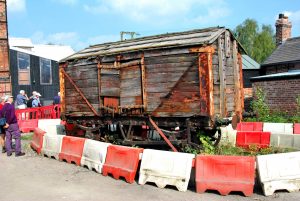 |
The Lion Salt Works relied on the rail network in parallel with the adjacent canal. The salt wagon (left) is typical of that used in the industry and is to be restored to be displayed at the revitalised salt works: £20,000 was awarded. Verdant Work’s Boulton & Watt rotative engine of 1801-2 in Dundee is one of the world’s most important remaining engines. £20,000 has been allocated for its restoration and display. The Boiler Header Pond at Crofton Pumping Station is thought to be contemporary with the 1812 Boulton & Watt engine. Restoration of the Header Pond will enable it to be used for refilling the boiler. £7,000. |
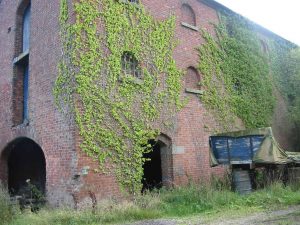 |
Two very fine Grade II listed 19th century canal warehouses at Wappenshall Wharf (left) in Shropshire designed by Thomas Telford. £20,000 has been allotted for their restoration. |
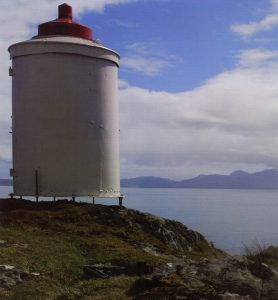 |
The Colonsay light chamber (left) was built by David A Stevenson in 1903 at Scalasaig, the main harbour and ferry terminal for the island. £4,300 has been granted for its renovation and display. |
| In 2013 four awards were made: | |
 |
Further restoration of the Danzey Green Windmill (left) at the Avoncroft Museum of Buildings, £6,790. Work has been completed. Restoration of the derelict Bowbridge Lock on the Thames & Severn Canal by the Cotswold Canal Trust, £20,000. After some initial engineering problems work is now proceeding well. Restoration of a 1950 Thompson composite corridor railway carriage No 18477 by the London & North Eastern Railway Coach Association, £15,000. Work is due to start soon. Rebuilding of the 1927 Ryde Pier Tram No 2 on the Isle of Wight Steam Railway by the Isle of Wight Railway Company. £15,000. Work on this project has been delayed due to problems with the condition of the operational IOW coaches. |
| Two restoration Grants were made for 2012: | |
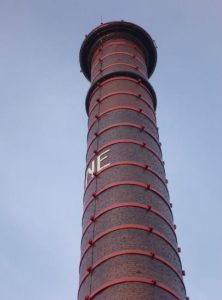 |
Grane Mill in Haslingden, Lancashire for the restoration of the top of the chimney (left) which was on the point of collapse. Grane Mill is important as one of the very few former Lancashire weaving mills that survives with its engine and boilers intact. Work is being conducted by the Heritage Trust for the North West on the long term restoration of the site. The consolidation of the chimney was one of the essential pieces of work that needed to be carried out before any progress could be made on the restoration of the rest of the site. This work was completed in the autumn of 2012. The Tramway Museum Society at Crich in Derbyshire. This grant has been made, not for trams, but for the consolidation and interpretation of rare surviving remains of a lead smelter on the Society’s Crich Tramway Village site. After a series of delays this project is due for completion in early 2015. |
| Five Grants were made in 2011: | |
 |
The Narrow Gauge Railway Museum Trust was awarded £2,000 towards the cost of rebuilding of a wagon weigh bridge (left). This project has been completed and the finished weighbridge and the associated building can be seen at Wharf Station on the Talyllyn Railway. |
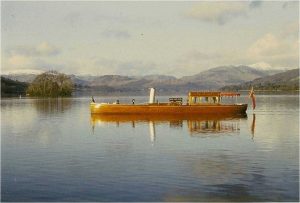 |
Lakeland Arts Trust has been awarded a grant of £15,000 towards the restoration of Steam Launch Osprey (left) at the Windermere Steam Boat Museum. Work is now well advanced on this project. |
| Mellor Archaeological Trust have had an award of £15,000 for the excavation and interpretation of the Wellington Wheel Pit at Mellor Mill. The work has been completed and the site is now open to the public. The Robey Trust have been awarded £10,000 towards the cost of moving and restoring a rare Robey undertype steam engine. The removal from the original site has been completed and work is progressing on the restoration. Ellen Road Steam Museum has been awarded £12,000 for the overhaul of the preserved Petrie Beam engine. Work on this project commenced in early 2012 and is now complete. | |
| In 2010 awards were made to the following and : | |
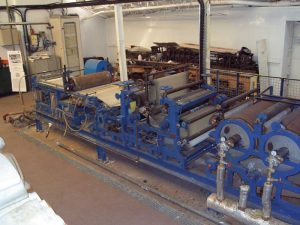 |
Repairs to the narrowboat ‘Tarporley’ at Camden Canals in London, £3,500. Restoration of a 19th century papermaking machine (left) for display in working order at Frogmore Mill, The Apsley Paper Trail, £9,870. Both projects are now completed |
| The first Grants were awarded in 2009: | |
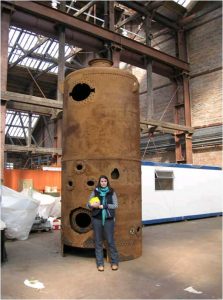 |
The Scottish Maritime Museum was awarded a grant of £2,750 towards the restoration of the original vertical cross-tube boiler from the Clyde puffer VIC 32 (left). This project is now complete and the boiler is on display. The South Yorkshire Trades Historical Trust were awarded a grant of £5,000 towards the restoration of the stone slate roof of the Hoylandswaine Nail Forge. The roof repairs have now been finished. The Beamish North of England Open Air Museum was awarded a grant of £14,000 towards the restoration of two Londonderry Chaldron Waggons. The project is completed and the waggons are on display in the colliery area at Beamish. The Boat Museum, Ellesmere Port was awarded a grant of £15,000 towards the restoration of Box Boat No 337 and boxes. After some problems sourcing timber and getting craneage the project is now complete and the boat back in the water. |
